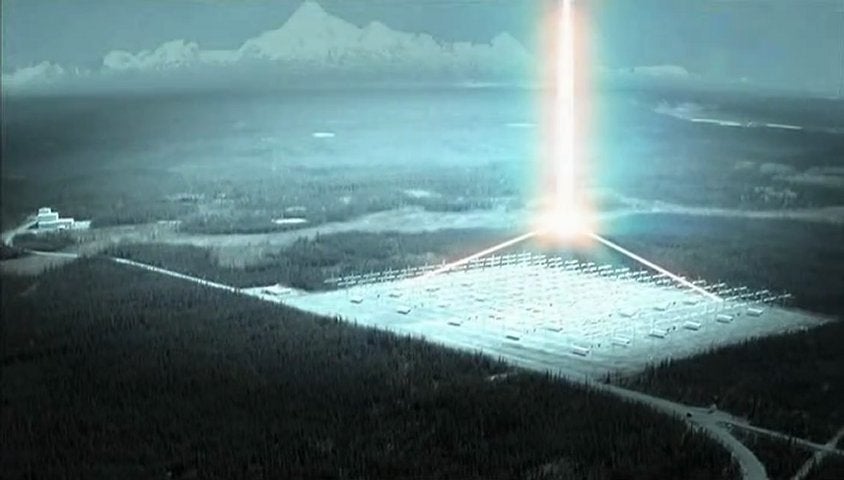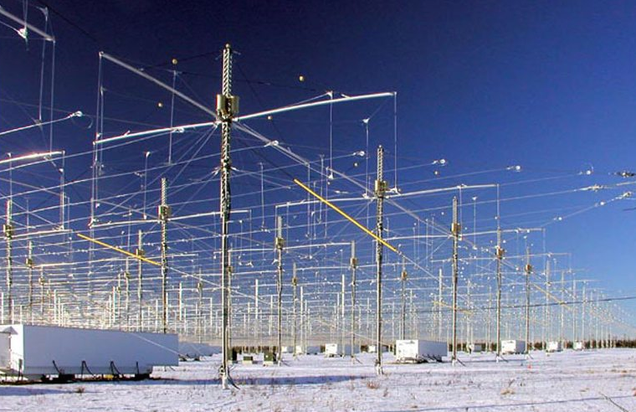Geoengineered Weather Patterns Wreaking Havoc Across The Planet
Chemtrails and HAARP are the Smoke and Mirrors behind the fabricated ‘Global Cooling’ events
The winter of 2013/2014 will go down as the year when the curtain was
pulled back on the fairly recent geoengineering scheme known as ‘Global
Cooling’. This fastidiously coordinated deception has been designed to
bamboozle the public into believing that
Global Warming was no longer the serious threat that it actually is. Not only is
Global Warming very real, it stands as the most formidable challenge facing humanity for the foreseeable future.
The actual state of affairs brought about by a firmly established Global Warming
phase is so dire and imminent that those who populate the world power
structure know that they are powerless to stop it. Hence, they[1] go to
great lengths to divert, distract, deceive, and delude us. Perhaps the controllers of the realm really believe that the people cannot handle what is surely
coming around the corner.
Or else why would they employ the likes of HAARP and Chemtrails 24/7
virtually everywhere around the globe to engineer extreme, unseasonal
and/or unprecedented weather?
CHEMTRAILS: A Planetary Catastrophe Created by Geoengineering
Let’s be very clear from the outset of this exposition: The entire
scientific and academic research establishment has access to the most
accurate information and data concerning the true state of the planetary
environment. They also have a very good fix on the
rapidly changing solar system
as well as other luminaries, which they gaze at though an assortment of
sophisticated observatories and high-powered telescopes. The Russians
in particular have documented these dramatic changes, which all point
emphatically in the direction of
Global Warming. The most
accurate scientific evidence to date conclusively reflects conditions,
which have occurred before during periods of the precipitous warming of
the planet.

Why are they so determined to hide the obvious evidence demonstrating Global Warming?
When both the scientific and anecdotal evidence irrefutably
supports a warming scenario, the geoengineers must work ten times harder
to prove their fraudulent point. There is no better defense
than a very deliberate offense. In this regard they are working triple
time to engineer various weather events which have caught many unaware.
Truly, the many weather modification techniques, which they are now
using with extraordinary effect, is succeeding at tricking some of the
best and brightest among us.
As they become more skillful at creating whole new climatological
patterns regionally, they show that they can manipulate the weather
virtually anywhere, anytime they want.
This misapplication of scientific knowhow and technological prowess is extremely dangerous,
especially when placed in the hands of the highly misguided and
deluded. This quite unfortunate predicament is similar to giving
matches and dynamite to the neighborhood children playing in a sandbox. How can it not end badly … very badly!
Back to the question of why they are “so determined” to the point of
ignoring scientific realities. They have already seen firsthand the
countless consequences of the inexorable
Global Warming trend
that has been upon us for decades. The following examples are just a
few of those radical changes which have been observed by scientists and
researchers throughout the world.
• Coastlines around the globe are being altered in unpredictable and dramatic ways
• Freshwater supplies are being threatened on every continent
• Century-old precipitation patterns are changing more with each passing year
• Species extinctions are occurring at an unprecedented rate
• Rainforests are disappearing, new deserts are being ‘created’
• Many lakes and rivers are losing their traditional water volume; others are gaining
• Islands are gradually being submerged by the ocean as sea levels rise
• Wildlife is under threat, especially in various locations in the Arctic
• Glacier melt is occurring with greater speed transforming landscapes on every continent
• Wildfires, forest fires, brush fires are much more frequent and larger than ever
• Mudslides and avalanches are claiming more lives and causing more property damage
• Record droughts and deluges are being recorded in virtually every nation
• Worldwide agricultural output has been seriously affected by both Global Warming and the geoengineered weather modification

Ocean floods A1A along Fort Lauderdale Beach, Florida
As a result of these and many other major changes occurring
incessantly under the radar, a short list of other forecasted impacts
was prepared and included in an IPCC report[2].

For
the average resident of Planet Earth, the preceding trends and ongoing
changes may not present an alarming scenario only because they might not
be occurring in your own back yard. However, when considered in the
aggregate by those decision-makers who “control the realm”, they make
for an ironclad and incontrovertible case for the extraordinary and
unstoppable transformation of the planetary civilization. In view of
what they see is literally
coming around the corner,
they have justified — in their own minds — these geoengineering
programs, which have now placed the entire global environment in great
jeopardy.
 The geoengineers preoccupation with their newfound
ability to play god with the weather is actually throwing significantly
more fuel on the raging fires of Global
Warming.
The geoengineers preoccupation with their newfound
ability to play god with the weather is actually throwing significantly
more fuel on the raging fires of Global
Warming.
Just in case you don’t get it, the best way for those who are determined to downplay
Global Warming is
to promote its opposite — ‘Global Cooling’. Not only does this
calculated strategy drive another HUGE wedge issue into the public
discourse, it also confuses the heck out of everyone. Even much of the
alternative news side of the internet has been taken over by this false
narrative. Otherwise very smart and aware people have been
uncharacteristically convinced that we are now entering a period of
‘Global Cooling’?!
In so doing, the controllers are enlisting many among us to advocate their geoengineering agenda as a way to combat Global Climate Change,
no matter what form anyone thinks it is shaping up to be. By
exercising control over the flow and accuracy of information on info
super-highways of the internet, too many are now tricked into buying
into a completely fictitious storyline. Therefore, it is imperative to
arrest their momentum before their geoengineering programs quickly take
us to a point of no return.
WHY?
Because points of no return must be taken very seriously; if not for
us, then for all future generations. The current “pharmaceutical
approach”[3] being regularly utilized to maintain this mirage of ‘Global
Cooling’ is actually exacerbating the progressing planetary problem of
Global Warming.
It’s not like they can just create a spate of artificially nucleated
snowfalls or ice storms and expect them to mitigate the effects of
Global Warming.
On the contrary, when the geoengineers transport moisture from the
GOM (Gulf of Mexico) up to the Arctic as a way of artificially reforming
a melted polar ice cap as they have been doing, or contort the Jet
Stream southward into the Deep South of the USA to produce unheard of
snow storms and ice storm in that region, they profoundly upset the
natural processes of atmospheric activity.
These meteorological machinations will cause unavoidable blowback.
Just as we have seen over the past couple of decades in the form of
massive, unrivaled storms of every sort and kind. The following link
contains a list of abnormal and destructive weather events for just
2013.
2013 Sees Weather Records Set Worldwide: Storms Are Bigger And More Ferocious

Atlanta, GA during recent snow storm
Geoengineering is affecting much more than the weather;
seismic activity and volcanism are also being provoked and triggered as
well.
The real point of this essay is to underscore the unintended
consequences, which are occurring around the globe, due to ill advised
and dangerous geoengineering techniques. In that this “pharmaceutical
approach” to ‘fixing’ the weather is now regularly causing violent local
weather events, severely altering climate patterns and producing even
greater meteorological repercussions around the globe, geoengineering
must be terminated “by any means necessary”.
What is not observed, except by very few who have the
capacity to make the necessary connections, are the far-reaching
ramifications which geoengineering is having on the vital signs of
Mother Earth. It is quite often misunderstood by the scientific
establishment that the weather of the world only has superficial impact
on the Earth’s surface. However, it is well known in the
esoteric sciences that the worldwide weather patterns have a very
profound and fundamental impact on the Earth’s crust.
Herein lies the real rub … both literally and figuratively. There is
much greater interaction between the weather and the Earth’s surface
than what is commonly accepted by both geologists and meteorologists.
All the physical components of the Earth are intimately interconnected.
To ignore, or dismiss these deep connections, is to do so at our
peril.
Until they are recognized and truly understood, the
folly of geoengineering will only continue to wreak havoc on and within
the planet.

Mt.
Etna, Europe’s most active volcano, spews lava during an eruption as
seen from Acireale, near the Sicilian town of Catania, Italy, on
November 16, 2013. (AP Photo/Carmelo Imbesi)
More to the point, the “pharmaceutical approach” of today’s
geoengineering is now exerting massive influence on the various
geological strata and ocean currents of the world. When studied in the
aggregate, the resulting effects of geoengineering are translating to a
substantial uptick in earth movements such a earthquakes and volcanoes.
What
is being presented here is that the most physically disruptive
practices of geoengineering can operate as co-factors in the triggering
of these seismic and volcanic events.
Rare earthquakes follow rare winter storm in the South
The last decade has seen an unsurpassed increase in both of these
types of geological activity. 2013 alone has given geologists much
reason to pause and ponder what on Earth is really going on.
So is 2014!
2013 marks record year for the number of volcanoes erupting across the planet
As for the number of earthquakes 6.0 and above occurring worldwide, here’s a comprehensive list for 2013 at the following link:
Earthquakes in 2013 – 6.0 and higher on the Richter Scale
The key point in this discussion is that any time that temperature
and pressure, humidity and precipitation are siginificantly altered,
geological formations both near and far can be affected. Likewise, when
the ozone layer and ionosphere, solar radiation and cloud cover are
radically manipulated via HAARP and
chemtrails, geological
strata will react in ways that are both unseen and, therefore,
undetected. The subtlety of these earth changes and movements are
simply too difficult to perceive; unless, of course they are being
evaluated within the context of the appropriate esoteric sciences.
Those much more refined scientific paradigms, however, are not
currently recognized by the scientific research establishment.
Consequently,
humankind is deprived of necessary diagnostic and treatment modalities
which could assist in bringing the planet back into balance during these
tempestuous times.
For the layperson, it shouldn’t take too much imagination to
understand what might result when powerful frequencies are conveyed
through
chemtrails by HAARP from transmitters in Alaska, as
well as from those that are space-based. The failure to acknowledge the
highly consequential effects of these continuing geoengineering
operations permits the incremental geological changes to take place
without notice.
This continuing predicament then sets up the
earth plane for a volatility of cataclysmic events which, heretofore,
have never occurred within the realm of human experience.
 Climate Engineering Causes Winter Armageddon in the USA
Climate Engineering Causes Winter Armageddon in the USA
As always, the headlines tell the story much better than anything we
can write, especially about the
FATEFUL WINTER of 2013/2014.
Snow burying parts of Northeast in massive winter storm – CNN.com
Storms taking toll on families, schools in Northeast | Reuters
Winter Offensive Takes Toll on East Coast – NYTimes.com
BBC News – US killer winter storm marches north
Deadly storm blasts Northeast, after paralyzing South
Deadly cold snap in US shatters temp. records, sends even polar bears to shelter
US digs out from deadly storm, with more snow coming – Yahoo News
Deadly snow and ice storms hits US
Killer storm: 13 deaths blamed on winter blast as snow piles up – U.S. News
“Historic”, “Catastrophic” Winter Storm Paralyzes Atlanta As Pax Creeps Up East Coast
▶ 2014′s US and Canada Snowstorm ‘Hercules’ : 16 Killed in Record-Breaking Low Temperatures – YouTube
2014 North American cold wave – Wikipedia

Pennsylvania Turnpike turned into parking lot after 100-car pileup after ice storm.
The historic California drought has also given many reason to examine its true causes.
Given the very fragile condition of the US economy, California is the
last state that anyone would want to see a 500 year drought. And yet,
that’s exactly where it sits. The only difference is that the current
drought was entirely manmade. There are many satellite photos which
clearly illustrate the geoengineered wall, by way of
chemtrails and HAARP frequencies, that was erected off the West Coast.
There is no question that the relevant data and pertinent
satellite photos demonstrate that California and southern Oregon were
targeted to prevent precipitation from reaching their shores from the
Pacific Ocean. The normal weather pattern conveys much
rainfall across the Pacific and then across the land mass of both
states. These same types of storm systems, many originating in the West
Pacific, are also responsible for keeping Washington State so wet with
verdant rainforests.
California is where the geoengineers have really created an
unparalleled disaster. However, it now has both manmade and natural
causes. Not only have they systematically firewalled the state so as to
terminate all the seasonal rainfall, their actions have contributed
considerably to the favorable conditions that encourage wildfires,
brushfires and forest fires. Given the unrelenting, annual Santa Ana
winds, they have only served to throw more fuel on this fire by turning
that once agricultural “Garden of Eden” into a state-sized tinderbox.
Just in case you missed this developing “story of the year”, here is
another list of headlines which portrays just how formidable a
catastrophe the California drought has now become.
US West Faces ‘Worst Drought in 500 Years’
Severe Drought Has U.S. West Fearing Worst – NYTimes.com
BBC News – Drought-hit California unable to supply state water
California Drought Prompts Unprecedented Water Conservation Efforts
California Stays Rain-Free After Drought Emergency Declared
Driest year ever in California sparks fire, water fears
Sacramento, Calif., sets winter drought record of 47 days – UPI.com
No Rain in Sight as Los Angeles Nears Its Record for Driest Year Ever | NBC
What the California Drought Looks Like From Space – AOL

Drought emergency declared in Mendocino County, California

“The punishing drought that has swept California is now threatening the state’s drinking water supply.”
Source: News York Times
Has the weather in your neck of the woods gone BEZERK yet?!
If it has, you might begin taking a closer look at your skies to find
out why. By all accounts, chemtrails are now being sprayed throughout
the day and night at ever-increasing rates in every state. As they
intensify the chemtrail programs, the wierd weather has simultaneously
increased in all 50 states.
The correlation between
geoengineering and weather patterns that have gone bezerk has been
firmly established by those who track the relevant data and plot their
graphs accordingly.
At the end of the day it will be the reams of anecdotal evidence,
which is being accumulated by the millions who are now well aware that
the
chemtrail component of geoengineering, that indicts this misbegotten geoengineering technology.
Particularly
because it represents a chemical assault against the citizenry of every
nation that allows them, chemtrails will go down in history as the
greatest chemical assault against humanity ever committed.
The very acknowledgment of
Chemtrail syndrome has helped to sensitize those who are particularly vulnerable to this
New Millennium
malady. They can now experience for themselves just one harmful aspect
of this exceedingly destructive government-sponsored black operation.
Chemtrail
syndrome may in fact just be the straw that breaks the camels back.
When folks wake up in the morning with migraine headaches because of
night-long chemtrailing, they will hopefully be compelled to take the
appropriate action(s).
Conclusion:
Geoengineering has contributed mightily to the current worldwide
predicament of calamitous Global Climate Change. Because there is so
little understanding of this fact in the upper echelons of academia and
scientific research, sky spraying not only continues unabated,
geoengineering is also being ramped up wherever possible. This totally
unnecessary plight is guaranteed to bring about eventualities that we
will not want to see visited upon our children and grandchildren.
The only solution is an incomparable global grassroots effort
designed to educate, enlighten and empower the masses regarding the
chemtrailing of their skies. There are two things that everybody gets
angry about where it concerns
chemtrails. As follows:
I.
Nobody wants their blue skies turned gray in an hour or two from chemtrails; most everyone loves to bask in the sun.
II.
Nobody wants to have toxic chemicals rained down upon them from chemtrailed skies; everyone prefers good health over chemtrail syndrome.
Who would ever want to be exposed to such a daily
chemtrailing regime and their ruinous consequences?!
Cosmic Convergence Research Group
Submitted: February 15, 2014
cosmicconvergence2012@gmail.com

Do we really want to accept this as the new status quo? ? ?
Author’s Note:
Indisputable scientific research from Russia has already proven that
the Solar System has been experiencing an astonishing transformation
never seen before or catalogued in written history. The observed
metamorphosis is quite astounding for both its speed and profundity.
This unfolding transformation, incidentally, is inclusive of Planet
Earth.
Here is a series of papers written by a group of Russian scientists
which addresses some of the most extraordinary data to be published on
this subject. What ought to be kept in mind as this information is
contemplated is that these findings were published 17 years ago.
Therefore, we can only wonder how these various
“Planeto-Physical” processes have precariously evolved since then.
PLANETOPHYSICAL STATE OF THE EARTH AND LIFE By DR. ALEXEY N. DMITRIEV
Caveat:
Most do not have the capacity to properly comprehend the notion of how Global Warming
can in fact trigger freakish weather that might otherwise indicate a
momentary cooling. Nevertheless, we are compelled to introduce this
anomaly which infallibly occurs during periods of abrupt Global Climate
Change. In other words, it is quite possible for cooling events to take
place during protracted periods of obvious global warming.
However, most of what we see today are weather events that are
engineered from beginning to end. Just like the five hurricanes that
were manufactured during the summer of 2005.
Remember
Dennis,
Emily,
Katrina,
Rita, and
Wilma. They represent “
the the most active Atlantic hurricane season in recorded history, shattering numerous records … [causing] an estimated 3,913 deaths and record damage of about $159.2 billion.“
(Source: Wikipedia)
Each of the three hurricanes in the GOM (Katrina, Rita and Wilma)
were proven to have been HAARP-driven by those who analyzed and
correctly interpreted the data by identifying the distinctive HAARP
signatures. The fact that each of those hurricanes was mysteriously
revved up to Category 5 within a very short and unlikely period of time,
just prior to landfall, was the dead giveaway to anyone who was
watching the TV screen. So we know with certainty that geoengineering
technology can bring about catastrophic results, whenever they push
their buttons and pull their switches to effectuate specific outcomes.

HAARP
is the High Frequency Active Auroral Research Program. It is an
ionospheric research program jointly funded by the U.S. Air Force, the
U.S. Navy, the University of Alaska, and the Defense Advanced Research
Projects Agency.
Endnotes:
[1] ”They” variously refers to the many different named groups that
are commonly used for the cabal, the controllers, the decision-makers,
the real power-brokers, movers and shakers, and financiers, the World
Shadow Government, the Global Control Matrix, etc. who are running the
planet from the very top.
[2]
The Current and Future Consequences of Global Climate Change
[3] The “pharmaceutical approach” describes the methodology of
treating Global Climate Change as a set of symptoms. Geoengineering in
the form of
chemtrails and HAARP then become the pharmaceutical remedies, which only treat the symptoms, not the underlying causes.
This approach, especially when pursued over the long term, virtually
always exacerbates the real problem. By not addressing the root causes,
geoengineering is actually making the problem much worse, just as
pharmaceutical medications will often give rise to adverse side effects
making the patient much sicker.
In the case of relentless HAARPing and
Chemtrailing, there
exists the much greater potential to cause catastrophic outcomes the
world over. These are already starting to appear in the form of
unintended consequences to regional weather patterns, collateral damage
to the environment, and toxic side effects for all living organisms.
References:
Main Stream Media “Scientists” Try To Cover Up Engineered Snow Storms.
Mainstream Media Desperately Trying To Hide The Truth About Climate Engineering
What is going on with the strange snowfalls this winter?
Resources:
GeoengineeringWatch.org
Global Skywatch: Chemtrails & Geoengineering
Recommended Reading:
Global Climate Change: Causing Worldwide Weather Apocalypse
AWESOME Earth Changes Coming Around The Corner
CHEMTRAIL SYNDROME: A Global Pandemic Of Epic Proportions
CHEMTRAILS: Covert And Ongoing Crimes Against Humanity
The Government-Coordinated CHEMTRAIL Conspiracy Continues Unabated
The US Government Commits Chemical Assault Against Its Citizens

© 2014 Cosmic Convergence: 2012 and Beyond
Permission is granted to post this essay as long as it is linked back to the following url:
http://cosmicconvergence.org/?p=6184




































































